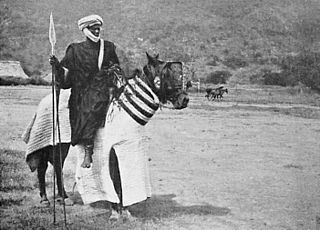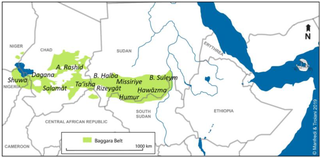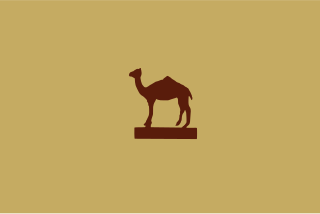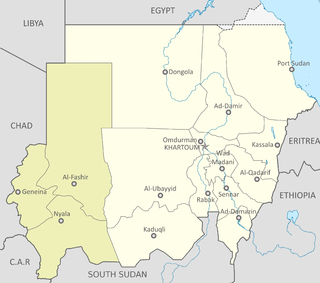This article relies largely or entirely on a single source .(March 2009) |
Awlad Himayd is a group of people who are part of the greater Baggara Arabs tribes of Kordofan and Darfur that includes the Habbaniya and Ta'isha.
This article relies largely or entirely on a single source .(March 2009) |
Awlad Himayd is a group of people who are part of the greater Baggara Arabs tribes of Kordofan and Darfur that includes the Habbaniya and Ta'isha.
They speak Sudanese Arabic. Awlad Himayd live in eastern parts of South Kordofan. They were nomadic people who shared routes (sig. Morhal, pl. Marahiil) with the Halafa, a branch of the Hawazma, and the Kenana and Habbaniya tribes. Their travels take them as far as the Shilluk and Nuer of the White Nile. Their inner southern nomadic area is part of the wilderness of South Kordofan, a dense high savanna forest land.
The majority are pastoralists, and the rest are farmers; they grow all types of South Kordofan crops: sesame, millets, okra, and ground nuts. They grow Gum Arabic and collect gums and honey from the woods.
They are widely viewed among Baggara peoples as being courageous; great hunters of elephants and big game like giraffe, antelope, tiang, and Ostrich; they are also known as great fighters of wild beasts such lions, tigers, wolves, and others at earlier times. Baggara people are good hunters and gatherers of wild fruits, wild okra, and honey from undomesticated bees. Gray-bees (Nahala el ghibasha in Arabic), the fiercest type of bee in South Kordofan, are nicknamed "Awlad Himayd" because of their courage.
The Awlad Himayd belong to the wider group of Baggara Arabs of Kordofan and Darfur. They are Sunni Muslims. MacMichael [1] mentioned that their Arab ancestors may have settled around Tekali in the eastern part of South Kordofan at a time of the great Guhayna movement, and they have been reinforced by others of their kin who have returned from the western countries (probably from present-day Chad).

The demographics of Sudan include the Sudanese people and their characteristics, Sudan, including population density, ethnicity, education level, health, economic status, religious affiliations, and other aspects of the population.

The Baggāra or Chadian Arabs are a nomadic confederation of people of mixed Arab and Arabized indigenous African ancestry, inhabiting a portion of the Sahel mainly between Lake Chad and the Nile river near south Kordofan, numbering over six million. They are known as Baggara and Abbala in Sudan, and as Shuwa Arabs in Cameroon, Nigeria and Western Chad. The term Shuwa is said to be of Kanuri origin.

The Janjaweed are a Sudanese Arab militia group that operates in Sudan, particularly in Darfur, and eastern Chad. They have also been speculated to be active in Yemen. According to the United Nations definition, Janjaweed membership consists of Sudanese Arab tribes, the core of whom are from the Abbala Arabs, traditionally employed in camel herding, with significant recruitment from the Baggara, who are traditionally employed in cattle herding.
The Fur are an ethnic group predominantly inhabiting western Sudan. They are concentrated in the Darfur region, where they are the largest ethnic group. They speak the Fur language, which belongs to the Nilo-Saharan family.

Western Bahr el Ghazal is a state in South Sudan. It has an area of 93,900 km2 (36,255 sq mi) and is the least populous state in South Sudan, according to the controversial Sudanese census conducted in 2008. It is part of the Bahr el Ghazal region. Its capital is Wau. The state shared international borders with Sudan to the north and the Central African Republic to the west. The portion now occupied by Raga County is the southern part of the historical region known as "Dar Fertit".

Hawazma, part of Sudan's Baggara tribe, are cattle herders who roam the area from the southern parts of North Kurdufan to the southern borders of South Kurdufan, a distance of about 300 kilometers. Through their nomadic movement, the Hawazma know the area, terrain, ethnic groups, local tribes, tribal cultures, ecosystems, climate, vegetation, existence of risks and diseases, and water resources better than any other inhabitants of the region. The term Baggara is a collective name applied to all cattle-herding tribes with Arab roots. Cattle herders from Nuba tribes are not called Baggara. Cattle herders of middle and eastern Sudan, although they Arabic in roots, are also not Baggara. The Baggara occupies a wide area, from Kordofan, Mid-Western Sudan, to Darfur in the far Western Sudan and extending to neighboring Chad. They are a collection of seven major tribes: Hawazma, Messiria Humr Messiria Zurug, Rizeigat, Ta’isha, Habbaniya, Beni Halba, Awlad Himayd, and Beni Selam. All Baggara have close physical characteristics, costumes, dance, religion, food, and in general a common culture and way of life.

Kordofan is a former province of central Sudan. In 1994 it was divided into three new federal states: North Kordofan, South Kordofan and West Kordofan. In August 2005, West Kordofan State was abolished and its territory divided between North and South Kordofan States, as part of the implementation of the Comprehensive Peace Agreement between the Government of Sudan and the Sudan People's Liberation Movement. West Kordofan was reestablished in July 2013.
The Zaghawa people, also called Beri or Zakhawa, are a Sahelian ethnic group primarily residing in southwestern Libya, northeastern Chad, and western Sudan, including Darfur.

Ta'isha, or Ta'aisha, or Taaisha, one of a series of Arabic-speaking groups collectively called Baggara "cattle people", who live in Sudan, across southern Kordofan, Darfur, as well as Chad. The Ta'aisha tribal homeland is in the far southwest of Darfur, neighbouring to the east the Habbaniya, with whom they are closely related. The Ta'aisha rose to power when one of the members of their tribe, Abdallahi ibn Muhammad, later known as the Khalifa, became an early follower of Muhammad Ahmad, who would later become the Sudanese Mahdi. During the revolution, 'Abdallahi became the strongman of the movement and was designated as senior Khalifa by the Mahdi. Following the Mahdi's death in June 1885, the Khalifa 'Abdallahi ruled the Mahdist state until its destruction by an Anglo-Egyptian army. The Khalifa during his rule brought his tribe to Central Sudan and he went on to make extensive use of his relatives and other fellow Ta'a'isha as soldiers and administrators. Throughout the Mahdist period there was constant tension between the Ta'aisha leaders and the riverain Sudanese. Several Ta'aisha amirs who survived the Mahdiyya became prominent at the re-established Darfur Sultanate of Ali Dinar, one being Arabi Dafallah, who was appointed commander of the Equatorial province with its headquarters at Rejaf under the Khalifa's rule. Having been forced in 1897 to evacuate Equatoria by Belgians advancing from the Congo, he had made his way into southern Darfur where he faced Anglo-Egyptian forces and friendly tribes sent by Kitchener in pursuit of him. He then settled in the area of the present Central African Republic-Darfur border where he came into contact with encroaching French colonial power. After an unsuccessful attack on French outposts in the region he surrendered to Sultan 'Ali Dinar with his men and their arms in 1902, he subsequently lived in Al-Fashir and took part in many of the Sultan's military expeditions. Another one was 'Ali al-Sanusi, who was a Mahdist amir under Mahmud Ahmad in Atbara and fought at Karari after which he escaped to Darfur to be one of 'Ali Dinar's best generals. Under the British colonial rule, He was appointed Nazir of the Ta'aisha in Darfur and rendered valuable service to the new administration.

The Rizeigat, or Rizigat, or Rezeigat are a Muslim and Arab tribe of the nomadic Bedouin Baggara people in Sudan's Darfur region. The Rizeigat belong to the greater Baggara Arabs fraternity of Darfur and Kordofan and speak Chadic Arabic. They are primarily nomadic herders and their journeys are dependent upon the seasons of the year. They are a branch of the Juhayna group. They are divided into the Abbala (camel-herding) Rizeigat, who live in northern Darfur and Chad, and the Baggara who inhabit south-east Darfur. In turn they are divided into several large clans, notably the Mahamid, Mahariya and Nawaiba. The ecological differences between the north and south of Sudan allowed for two different types of nomadism to evolve: camel herders in the north and cattle herders in the south.
The Habbaniya, or Habbania, are a Sunni Muslims tribe of the nomadic Bedouin Baggara people in the plains of Sudan's Darfur, North Kurdufan, and South Kurdufan provinces
Gawamaa or Gawám'a is a Sudanese ethnic group. They are a large sedentary tribe in North Kordofan, and sections of them also helped form the Halafa sub-group of the Hawazma tribe, itself a sub-group of the larger Baggara group. According to British colonial administrator Harold MacMichael, the Gawamaa were one of six non-Hawazma tribes integrated into the Hawazma tribe in the mid-eighteenth century by way of an oath.

The Messiria, known also under the name of Misseriya Arabs, are a branch of the Baggara ethnic grouping of Arab tribes. Their language is Sudanese Arabic. Numbering over one million, the Baggara are the second largest ethnic group in Western Sudan, extending into Eastern Chad. They are primarily nomadic cattle herders and their journeys are dependent upon the seasons of the year. The use of the term Baggara carries negative connotations as slave raiders, so they prefer to be called instead Messiria.

The Beni Halba is an Arab group located in the western Sudanese region of Darfur. The Beni Halba is one of the major Darfuri Baggara groups, along with the Habbaniya, Rizeigat and Ta’isha, and was granted a large hakura in southern Darfur by the sultans of independent Dar Fur. During the 1980s, recurring drought in Chad prompted several clans of Beni Halba to migrate eastwards and join their kinspeople between Geneina and Kebkabiya and Kutum. In the late 1980s, the ideology then sweeping through the region combining Arab supremacy and Islamic extremism was taken up by many Beni Halba. Under Nazir al-Hadi Issa Debaker, the Beni Halba were actively involved in attacks upon the Fur people starting in 1987 through 1989. In this period a new militia called the Janjaweed, partially drawing upon the Beni Halba, was first formed. In 1991 the Sudan People's Liberation Army, then fighting the Second Sudanese Civil War in the south of the country, sent a force under Daud Bolad to expand the conflict into Darfur. However, Bolad's force was annihilated by a combination of the army and Beni Halba fursan ("horsemen"), who then carried out reprisal attacks against Fur civilians. As a result, the Beni Halba district town of Idd al Ghanam was renamed Idd al Fursan.

Throughout its history, Darfur has been the home to several cultures and kingdoms, like the mythical Tora or the Daju and Tunjur kingdoms. The recorded history of Darfur begins in the seventeenth century, with the foundation of the Fur Sultanate by the Keira dynasty. In 1875, the Anglo-Egyptian Co-dominion in Khartoum ended the dynasty. The British allowed Darfur a measure of autonomy until formal annexation in 1916. However, the region remained underdeveloped through the period of colonial rule and after independence in 1956. The majority of national resources were directed toward the riverine Arabs clustered along the Nile near Khartoum. This pattern of structural inequality and overly underdevelopment resulted in increasing restiveness among Darfuris. The influence of regional geopolitics and war by proxy, coupled with economic hardship and environmental degradation, from soon after independence led to sporadic armed resistance from the mid-1980s. The continued violence culminated in an armed resistance movement around 2003.

Chadian Arabic, also known as Shuwa Arabic, Baggara Arabic, Western Sudanic Arabic, or West Sudanic Arabic (WSA), is a variety of Arabic and the first language of 1.6 million people, both town dwellers and nomadic cattle herders. The majority of its speakers live in southern Chad. Its range is an east-to-west oval in the Sahel. Nearly all of this territory is within Chad or Sudan. It is also spoken elsewhere in the vicinity of Lake Chad in the countries of Cameroon, Nigeria, Niger. Finally, it is spoken in slivers of the Central African Republic, and Libya. In addition, this language serves as a lingua franca in much of the region. In most of its range, it is one of several local languages and often not among the major ones.

Sudanese Arabs are the inhabitants of Sudan who identify as Arabs and speak Arabic as their mother tongue. Some of them are descendants of Arabs who migrated to Sudan from the Arabian Peninsula, although the rest have been described as Arabized indigenous peoples of Sudan of mostly Nubian, Nilo-Saharan, and Cushitic ancestry who are culturally and linguistically Arab, with varying cases of admixture from Peninsular Arabs. This admixture is thought to derive mostly from the migration of Peninsular Arab tribes in the 12th century, who intermarried with the Nubians and other indigenous populations, as well as introducing Islam. The Sudanese Arabs were described as a "hybrid of Arab and indigenous blood", and the Arabic they spoke was reported as "a pure but archaic Arabic". Burckhardt noted that the Ja'alin of the Eastern Desert are exactly like the Bedouin of Eastern Arabia.

The Humr are one of two branches of the Messiria, a subgroup of the Baggara ethnic group, native to the south-west of province Kordofan, Sudan. Speakers of Chadian Arabic, the Humr live in the area surrounding the towns of Babanusa, Muglad and Al Fula.

Sudanese nomadic conflicts are non-state conflicts between rival nomadic tribes taking place in the territory of Sudan and, since 2011, South Sudan. Conflict between nomadic tribes in Sudan is common, with fights breaking out over scarce resources, including grazing land, cattle and drinking water. Some of the tribes involved in these clashes have been the Messiria, Maalia, Rizeigat and Bani Hussein Arabic tribes inhabiting Darfur and West Kordofan, and the Dinka, Nuer and Murle African ethnic groups inhabiting South Sudan. Conflicts have been fueled by other major wars taking place in the same regions, in particular the Second Sudanese Civil War, the War in Darfur and the Sudanese conflict in South Kordofan and Blue Nile.
Cyril Alexander Edward Lea was a British colonial officer in the Anglo-Egyptian Sudan in the first half of the 20th century. He is known for his famous diary which he called his "trek journals." They provide a glimpse of how British civil servants understood their role in the administration of native peoples.